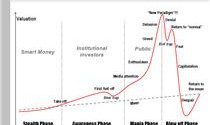An annualized average of 56% of all actively managed domestic equity funds, 59% of active U.S. large-cap equity funds, and 64% of active mid-cap equity funds underperformed broad-market indexes. [Index funds anyone? Let's review.] Words: 895
Read More »Physical Gold or Dividend Stocks – Which Are a Better Long-term Hold?
If you really want to be sure you’re keeping pace with inflation and own assets that can survive a crisis then forget gold. [A look at the evidence] tells us that over long periods of time, investors are better off holding stocks than gold. Words: 665; Table:1
Read More »Be Careful! Former Investment "Rules" Nolonger Work – Here’s Why
Investment “rules” that were relevant for a century are obsolete. They were based on a world where economies grew, people’s standard of living increased and outcomes tomorrow better than today. Arguably each of these conditions will not hold in the future but if they don't, neither do the rules of thumb that guided investing last century. These guiding principles developed and worked in a world that that no longer exists but applying them in the future will result in devastating financial outcomes. [Let me explain.] Words: 1261
Read More »Why – and How Much – Should One Invest In Gold & Silver?
No one can predict exactly what will rise up after the collapse of the current monetary system, but here is my take on how you can do your best to prepare yourself no matter what happens.
Read More »Both Stocks & Bonds Could Decline By 75% – Yes, 75%! – In Coming 10 Years – Here’s Why (2K Views)
The current credit-bubble boom in stocks and bonds is getting long in tooth after 34 years of relentless expansion, and the rise of securities to 400% of GDP is reaching extremes that are increasingly difficult to support, much less push higher. As such, a reversion to generational lows is inevitable, and a valuation level around 50% of GDP for stocks is a fair target. This implies a 75% decline in both stocks and bonds within the next decade, if not sooner.
Read More »Where Are World’s 2 Biggest, Best & Most Powerful Investors Investing? Here’s Where & How (+2K Views)
A lot of people think that because they have a lot of money they’re wealthy but, in the short run while that may be true, in the longer run the money can go away. Wealth, however, is something that prevails and these 2 investors know exactly how to maximize theirs.
Read More »Should A Significant Portion of Your Portfolio Be In Gold?
If you had invested in gold in 2004 you would have earned about 10.4%, annualized. I am writing this article, though, to say that you should not consider gold to be a good long-term investment and you should not have a significant proportion of your portfolio in gold. Let me explain.
Read More »Interesting Comparison of U.S. Market-cap-to-GDP Ratio To 20 Other Countries
Two weeks ago, I wrote about Warren Buffett’s favorite tool for measuring the overall valuation of the market: the ratio of total market cap to GDP. Today, we’re going to dig a little deeper into that analysis and compare the U.S. market to 20 other countries you may be interested in investing. Take a look HERE at a chart showing the current market-cap-to-GDP ratio within the context of its historical range. You will find the results very interesting.
Read More »Major Market Gurus See Devastating Collapse of Global Bond Bubble Soon
There is literally nowhere for the bond market to go except down and, when this bull market turns into a bear, it will create chaos and financial devastation all over the planet.
Read More »Future Supply/Demand Makes Gold At Current Price A Must-buy Opportunity. Here’s Why
At its current pace there are 3 developments underway that paint an ominous picture of new gold supply soon becoming unable to keep up with demand which will push gold prices higher. In the meantime, the longer prices stay at current levels, the greater the impact. This setup makes current gold prices a must-buy opportunity.
Read More » munKNEE.com Your Key to Making Money
munKNEE.com Your Key to Making Money









